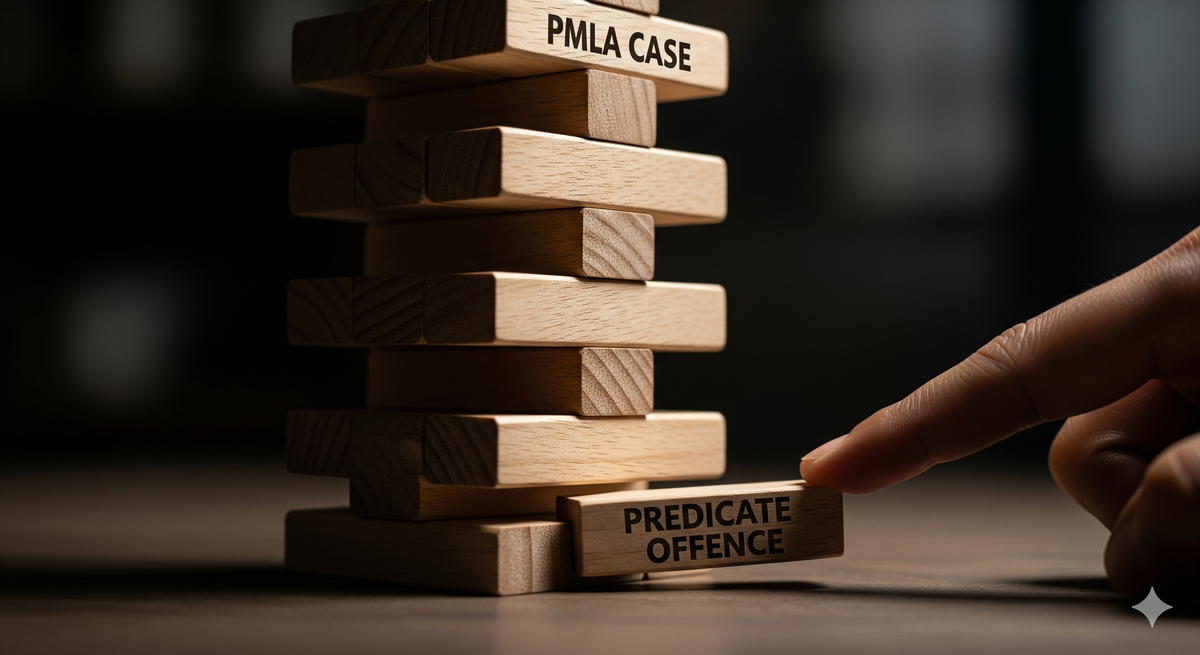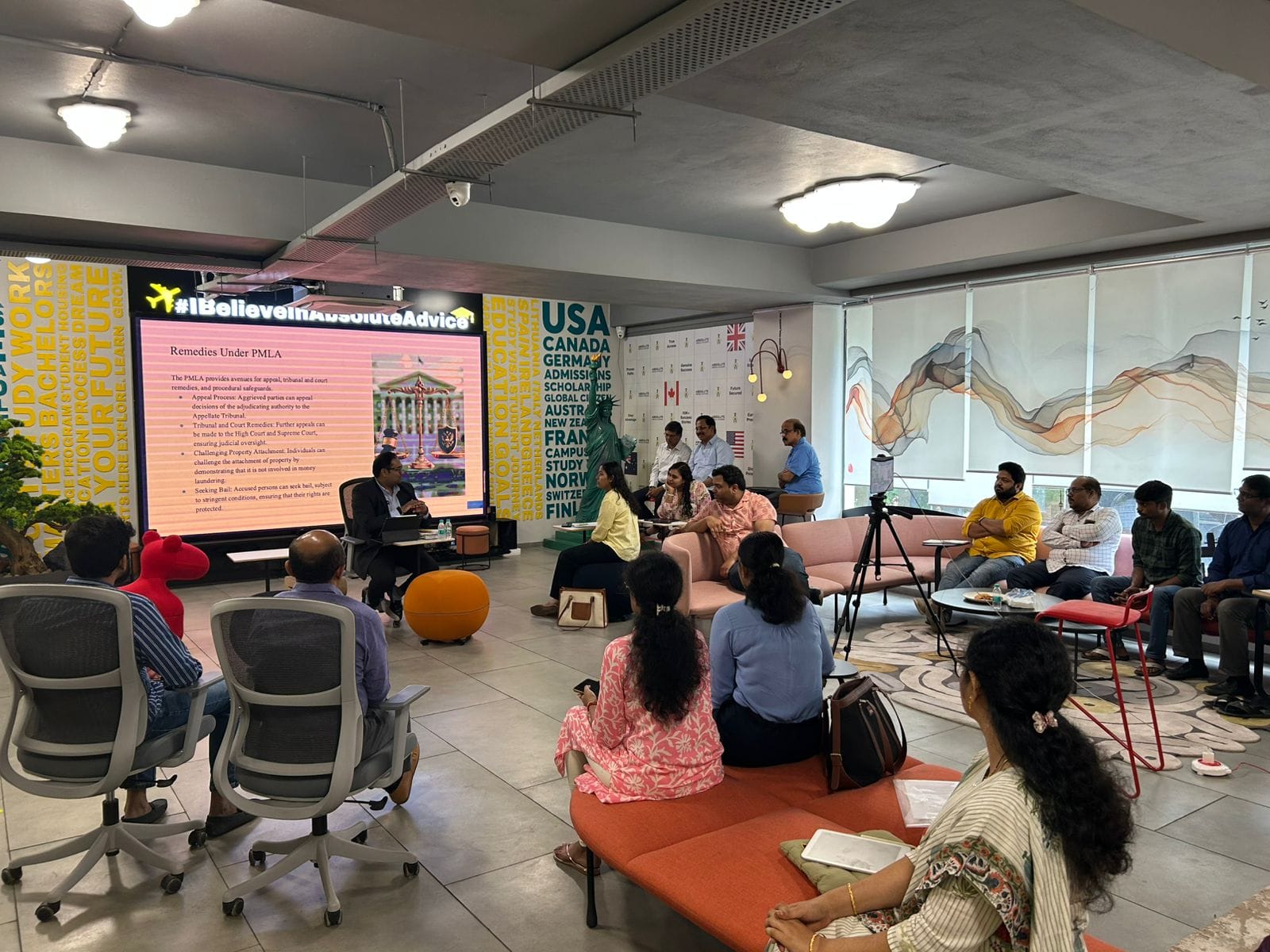PMLA Decoded by Advocate E Venkata Siddhartha - Notes
Notes from the 2 hour session where advocate Venkata Siddhartha breaks down the Prevention of Money Laundering Act for Law Students.

The below are my notes from the Session on PMLA on 6th September 2025 by Adv E Venkata Siddhartha hosted by 1516.
You can find the video here.
What is PMLA?
It is the Prevention of Money Laundering Act enacted by Parliament in 2002 after making promises in the international fora to bring in said legislation. BJP was in power at the time.
It came into force on July 1st 2005 when the Congress regime notified it.
History
- India was a signatory to the 1988 Vienna Convention which required member states to enact laws criminalising money laundering and drug proceeds.
- Financial Action Task Force (FATF) recommended that member states (of which India is one) enact Anti-Money Laundering (AML) laws. India subsequently had to enact such legislation which was enacted in 2002 called PMLA.
- India had no comprehensive legislation to combat money laundering before PMLA.
Intent
All laws are made with clear intent, it is not happenstance that a law shows up in Parliament and is passed by both houses and gets assent of the President.
It is a carefully calculated move that is made keeping in view the interests of the country at a macro level.
When any law is passed, it is extremely important for advocates to understand the intent behind the Act. Without understanding the intent, it is difficult to protect your client.
What is money laundering?
Taking tainted money and making it untainted is the act of money laundering. In simple terms, it is converting black money into white money.
Any money that is acquired by illegal means is called unaccounted cash aka black money. Corruption is one form of illegal means, but not the only one.
Who enforces PMLA?
Let us look at who enforces some other Acts.
- IPC/BNS - Police Department
- Prevention of Corruption Act - Anti-Corruption Bureau
- Prevention of Money Laundering Act (PMLA) - Enforcement Directorate (ED)
Constitutional Challenges
- PMLA has been challenged multiple times.
- Surprisingly, all sections of the PMLA have been upheld by the Supreme Court despite multiple challenges.
- A review petition that filed in April 2024 has been accepted and the court is yet to decide on the case.
- Vijay Madanlal Choudhary vs. Union of India was a major 2022 case which upheld the constitutional validity of the PMLA including major controversial sections.

Enforcement Directorate
ED cannot stand on its own legs
There is a concept of a predicate offence. A predicate offence is an offence that must be in the PMLA schedule as an offence under some other Act which is a pre-requisite for ED to register any case. ED cannot stand on its own legs i.e. if there is no predicate crime, it cannot file any case whatsoever.
ED deals with proceeds of crime and not with the crime itself. The crime under BNS or NDPS or any other Act must be dealt with by the enforcing authority and ED may only take cognisance after such a case has been registered. It is important to bear in mind that all cases are not permitted, only the cases which are mentioned in the Schedule of the PMLA can be taken as predicate offences. This is quite an exhaustive list which includes a plethora of offences.
What about innocent third parties?
In practice, ED is not yet knocking on the doors of ordinary people and saying you have benefitted from the 'proceeds of crime' defined u/s 2(1)(u).
However, the law u/s of PMLA says "Whosoever directly or indirectly attempts to indulge or knowingly assists or knowingly is a party or is actually involved in any process or activity connected with the proceeds of crime including its concealment, possession, acquisition or use and projecting or claiming it as untainted property shall be guilty of offence of money-laundering."
The essential question before ED is "Whether what you have is bought with proceeds of crime or not?". They will go through the entire chain.
Knowledge of an Offence
Knowledge of an offence is also a crime. If you are aware that there is a transaction of Rs 1 crore taking place and that only 10% i.e. 10L is shown on paper and the rest is in cash, mere knowledge of this transaction is also a crime. You are expected to volunteer this information to the authorities.
This recent controversy about the ED summoning advocates is about this 'knowledge'. The advocates may be privy to certain information and ED was attempting to get them to open up about this knowledge. The Supreme Court firmly reiterated that any communication between client and his advocate is covered by client-attorney privilege and cannot be disclosed to any third party.
Does the accused get punished twice?
Since ED cannot stand on its own legs and a predicate offence is required before ED can pursue any criminal, is the accused going to be punished for both offences?
If he is charged with corruption under Prevention of Corruption Act and also charged with a crime under PMLA, is he going to face punishment for both?
The answer is Yes.
Both are separate crimes under separate legislations and both will be tried accordingly and punished. The mere entering of ED into the investigation does not stall the existing investigation.
What is the equivalent of chargesheet in PMLA which is filed by ED?
The police/CBI etc file a chargesheet which is a list of charges against the accused. The equivalent of such a chargesheet filed by the ED is called complaint.
Furthermore, supplemental chargesheets can be filed by agencies like CBI or ACB etc based on the investigation done by the ED.
ED is concerned with Proceeds of Crime
Let us suppose a government official has misused his official capacity and gained unlawfully. The punishment for misuse of the official position is in the Prevention of Corruption Act and will be pursued by ACB but the ED will only focus on the "proceeds of crime".
Where did the proceeds which were generated through the said illegal transaction go? is the question that ED is interested in answering and it finds everyone in the network who is related to it.
1944 Criminal Ordinance
Before ED was in existence, there is an ordinance from 1944 that allows attachment/confiscation of properties that are from 'proceeds of crime'.
Procedure for Attachment of Properties normally compared with PMLA
Normally the procedure for any agency such as police is that they
- File an application with the court
- Mention 'reasons to believe'
- Get the attachment and separately, the possession.
However, under PMLA the ED can attach any properties within 180 days without requiring judicial intervention.

ECIR is not a public document
The First Information Report, FIR is a public document, anyone can see the contents of a FIR who is the accused, what are they accused of, the crime details etc.
However, when it comes to the Enforcement Case Investigation Report(ECIR), this document is purely an internal document that is made by the ED and is not a public document.
It is only when you receive the summons u/s 50(2) do you know that ED is looking into your affairs. It is issued by an officer no lesser than the joint director.
Why is ED not coming after all cases?
Shouldn't ED come after all the cases? For example, why hasn't it come into the AP liquor scam case?
ED has discretion on what cases it chooses to pursue.
CBI
CBI has come into existence from the Delhi Police Act. The CBI cannot automatically involve into all the cases. The state government(through GO) has to invite CBI to investigate or it can be done through judicial intervention under Article 226 by the High Court which has the powers to transfer the case to CBI.
Section 50(2) Summons
In a normal criminal case, the accused would know that he is being summoned as an accused based on the notice given u/s 35(3) BNSS.
However, in the notice issued u/s 50(2) of PMLA, the person does not know whether he is an accused or a witness.
Normally, if you know that you are going to be arrested, you will go to the court and request anticipatory bail. You will mention the words 'it has come to my notice' and mention that you maybe accused in a particular crime in a particular case. You will know something about the case.
To ask for anticipatory bail, you need to know the crime but in case of PMLA and ED, you do not know the crime and hence no such anticipatory bail applications are usually granted by any court.
Statement made in front of ED
Normally, u/s 161 Code of Criminal Procedure, the statement made in front of any investigating officer is not admissible. The accused is not under Oath (refer Oaths Act) and he may not make any statements incriminating himself.
Only statements made u/s 164 Code of Criminal Procedure are admissible because they are given under oath in the presence of a magistrate.
However, under PMLA, the investigating officer is also the adjudicating authority. Therefore, any statement made to him is admissible as evidence. Essentially, a person who has been issued a notice to appear u/s 50(2) can be made an accused based on the statement given by him. This is self incrimination and is a violation of is a violation of Art 20(3) in the Constitution of India. This has been challenged but it yet to be decided by the Supreme Court.
Burden of Proof
In Prevention of Money Laundering Act, the burden of proof falls on the accused and not the prosecution. The accused has to prove that he is not guilty of that offence.
In normal cases, the burden of proof falls on the prosecution to prove beyond reasonable doubt that the accused has committed the crime.
Bail
Manish Sisodia, the former Dy Chief Minister of Delhi was in jail for about 17 months. Under IPC, there is a default bail if the police does not file a chargesheet within 90 days. However, under Prevention of Money Laundering Act, this is not required. The same was upheld by the courts.
Why has ED been given sweeping powers under PMLA?
Tainted money which is unaccountable has the potential to do large scale damage. It could be used to fund terror, influence elections among other nefarious purposes. Powers to ED under PMLA are given to curb money laundering practices which would turn this tainted money into untainted money.
If ED wins a case, sometimes the exchequer benefits by 1000 crore. This is a win for the people of the country.
ED has filed 500 + cases
While we only hear about the cases through media in most cases, many cases do not appear in the news unless they are arresting some celebrity. The statistics say ED has filed over 500 cases in various scheduled offences.
Tripod Test
3 conditions to satisfy to get bail in any case
- There is no flight risk i.e. the person will not flee and will cooperate in the investigation even after the chargesheet is filed.
- No witness influencing: the accused will not influence any witness.
- No evidence destruction: no evidence will be destroyed by the accused.
If the advocate can satisfy the court in these 3 matters, the court can grant bail in the scheduled offences.
However, this does not apply to Prevention of Money Laundering Act.
"Bail is the right, jail is the exception" - Supreme Court
This does not apply to Prevention of Money Laundering Act.
There is no bail granted in PMLA cases until the prosecution is heard. Furthermore, the accused must prove at the prima facie level that he is going to be coming out of this case not guilty. This has to be mentioned in the prima facie argument itself.
You are no longer accused in the Predicate offence
If an offence has been registered and you are an accused, what happens if you are no longer accused when the chargesheet is filed?
ED will continue to investigate if there are any proceeds of crime that you maybe involved in and/or have been enjoyed by you.
U/s 45 of PMLA, the cases are cognisable and non-bailable. They can be reported by investigating agencies or they can be chosen by the ED itself with their discretion.
All of these are general points, they are not conclusive, each case has its own merits.
IBC Complexities with ED
The Insolvency and Bankruptcy Cody has facilitated several companies to be acquired by new owners by streamlining the process. After the entire process is complete and the new owner is enjoying the property, ED is now coming and questioning the said acquisition as proceeds of crime as the previous owner had some illicit sources of money and you are now enjoying the proceeds.
Example:
Anand takes a loan of Rs 200 crores from a bank and has no intention to repay. He sets up an industry with those 200 crores. Bank declares him a defaulter and files case. The industry goes into the Insolvency and Bankruptcy Cody proceedings and a new owner is officially appointed after he pays off the creditor. It is assumed that he has some profit here.
Now, ED comes knocking as the proceeds of crime were used to fund that industry and hence, you are enjoying the proceeds of crime therefore you are liable. ED wants to confiscate the property.
Complainant can be the Accused?
Example: X goes to ED to report a cheating case of Rs 3.5 crore which was registered by a police station in Hyderabad. During investigation, ED questions where this Rs 3.5 crore came from to the complainant.
ED will also look into the matter to see if this 3.5 crore is untainted money or tainted money in the first place.
My view on the session - Prithvi's Take
PMLA to me was an engima, I did not know what this Act did except for the basic thing about money laundering. I believe this is similar to most people as not too many people have so much money to launder it. Siddharth was a virtuoso. He knew the Act inside and out and is one of the few people who work with PMLA and ED cases from the client side. I am grateful that we could have Siddharth speak at 1516. Creating this content in Telugu has a large scale impact more than what most people can fathom. After learning about ED and PMLA, I am of the view that people cannot easily escape the legal system in the country.
If you at the timeline, you would know that police has been there since a long time. But Anti-Corruption Bureau had only come into existence after the Prevention of Corruption Act in 1988. ED has come into existence only after the Prevention of Money Laundering Act 2002. I am optimistic that the future is now looking bright and in the coming decade, India will solve all the problems that have plagued us for decades.
Siddharth's view on PMLA and ED
Siddharth is a nation-first person and is optimistic about the next 2 decades. The country today has so many laws that would make people think twice about committing a crime. He says these laws create a fear in the minds of the criminals that something will happen if they commit the crime.
Judgments/Acts mentioned by Siddharth
I have mentioned brief summaries, these are in no way exhaustive. Read the Act/judgment to get a proper idea.
-
Prevention of Money Laundering Act (2002)
Enacted to prevent money laundering, authorise confiscation of illicit assets, and ensure financial compliance. -
Taylor v. Taylor (1875) 1 Ch D 426
Established the rule that when a statute prescribes a procedure, it must be strictly followed and no alternative method is allowed. -
Lalita Kumari v. Govt. of UP (2014)
Held that police must register FIR upon receiving information about a cognizable offence; if denied, High Court can be approached for directions. -
Vijay Madanlal Choudhary v. Union of India (2022)
Upheld wide powers of Enforcement Directorate under PMLA and stringent bail conditions, maintaining ECIR as an internal document. -
Criminal Law Amendment Ordinance (1944)
Intended to prevent disposal or concealment of property acquired through offences involving government funds or property. -
Oaths Act (1969)
Lays out the procedure for administering oaths and affirmations to witnesses, interpreters, and jurors in courts, ensuring evidence is given truthfully. -
Wildlife Protection Act (1972)
Designed to protect India's wildlife and endangered species, create protected areas, and regulate hunting, trade, and conservation efforts. -
Prevention of Corruption Act (1988)
Targets corruption among public officials with strict penalties, special courts, and investigative powers to punish bribery and misconduct. -
Antiquities and Art Treasures Act (1972)
Regulates the export, trade, and registration of antiquities and art treasures to curb smuggling and preserve national heritage.


